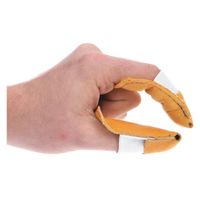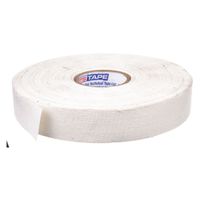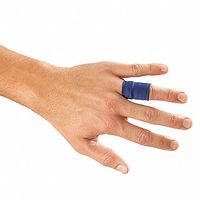Call +(254) 703 030 000 / 751 483 999 / 721 704 777
- Home
- Safety
- Hand Arm Protection
- Finger Protection
.....Read More
Frequently Asked Questions
What are finger protection products used for?
Finger protection products are designed to prevent injuries to fingers and hands in various environments. These products are commonly used in workplaces, homes, and recreational settings to safeguard against cuts, abrasions, crush injuries, and other potential hazards.
1. **Industrial and Construction Settings**: In these environments, finger protection products such as gloves, finger guards, and protective sleeves are essential. They protect against sharp tools, heavy machinery, and hazardous materials. Cut-resistant gloves, for example, are made from materials like Kevlar or stainless steel mesh to prevent lacerations.
2. **Sports and Recreational Activities**: Athletes use finger protection gear to prevent injuries during activities like rock climbing, basketball, or martial arts. Finger splints and tape are common to support joints and prevent hyperextension or fractures.
3. **Musical Instruments**: Musicians, particularly those who play string instruments, use finger protectors to reduce discomfort and prevent blisters or calluses during extended practice sessions.
4. **Medical and Healthcare**: In medical settings, finger cots are used to protect wounds on fingers or to prevent contamination during examinations and procedures. They are often made of latex or nitrile.
5. **Child Safety**: Finger pinch guards are used in homes and schools to prevent children from getting their fingers caught in doors. These are typically foam or rubber devices that fit over door edges.
6. **Food Industry**: Workers in the food industry use cut-resistant gloves to protect against knife injuries while preparing food.
Overall, finger protection products are crucial for safety and injury prevention across various activities and industries, ensuring that individuals can perform tasks efficiently without compromising their well-being.
How do finger cots protect fingers during assembly work?
Finger cots are protective coverings worn on fingers, typically made from materials like latex, nitrile, or rubber. They serve several protective functions during assembly work:
1. **Barrier Protection**: Finger cots act as a barrier between the skin and the components being handled. This prevents oils, sweat, and other contaminants from the skin from transferring onto sensitive parts, which is crucial in electronics or precision assembly where contamination can affect performance or cause defects.
2. **Injury Prevention**: They provide a layer of protection against minor cuts, abrasions, and punctures that can occur when handling sharp or rough-edged components. This is particularly important in environments where workers frequently handle small, delicate parts.
3. **Grip Enhancement**: The material of finger cots often provides a better grip than bare skin, reducing the likelihood of dropping components. This is beneficial in assembly tasks that require precision and control.
4. **Electrostatic Discharge (ESD) Protection**: Some finger cots are designed to be anti-static, which helps in dissipating electrostatic discharge. This is essential in electronics assembly, where static electricity can damage sensitive components.
5. **Hygiene and Cleanliness**: By covering the fingers, finger cots help maintain a clean working environment, which is critical in industries like pharmaceuticals and food processing where hygiene standards are stringent.
6. **Comfort and Dexterity**: Unlike full gloves, finger cots cover only the fingers, allowing for greater dexterity and tactile sensitivity. This is advantageous in tasks that require fine motor skills and precision.
Overall, finger cots are a simple yet effective tool in protecting both the worker and the product during assembly work, enhancing safety, quality, and efficiency.
What is the difference between finger guards and finger cots?
Finger guards and finger cots are protective devices used for different purposes, primarily to safeguard fingers during various activities.
Finger guards are typically designed to protect fingers from cuts, abrasions, and other injuries, especially in environments where sharp tools or machinery are used. They are often made from materials like metal, plastic, or rubber and can cover the entire finger or just the tip. Finger guards are commonly used in industrial settings, kitchens, and workshops to prevent accidents while handling knives, saws, or other cutting tools. They provide a barrier between the finger and potential hazards, reducing the risk of injury.
Finger cots, on the other hand, are small, tube-like coverings made from latex, nitrile, or other flexible materials. They are designed to fit snugly over a finger, similar to a condom, and are primarily used for hygiene and protection in medical, electronic, or laboratory settings. Finger cots protect against contamination, moisture, and static electricity. They are often used when handling small, delicate components or when a full glove is unnecessary. In medical settings, finger cots can be used to cover a bandaged finger to keep it clean and dry.
In summary, the main difference lies in their purpose and design: finger guards are for physical protection against cuts and injuries, while finger cots are for hygiene and contamination prevention.
How does finger tape provide protection?
Finger tape provides protection by offering support, reducing friction, and preventing injuries. It stabilizes joints, particularly in activities that involve gripping or repetitive motions, such as climbing, weightlifting, or playing musical instruments. By wrapping the tape around the fingers, it limits excessive movement, which can help prevent sprains or strains. The tape also acts as a barrier against cuts, blisters, and abrasions by reducing direct contact with surfaces. Additionally, it can absorb sweat, enhancing grip and reducing the risk of slipping. Finger tape can also compress and support existing injuries, promoting healing and reducing pain.
Can finger protection products be used in woodworking?
Yes, finger protection products can be used in woodworking to enhance safety and reduce the risk of injury. Woodworking involves the use of sharp tools and machinery, which can pose significant hazards to fingers and hands. Finger protection products are designed to mitigate these risks and provide an additional layer of safety.
1. **Gloves**: Specialized gloves made from cut-resistant materials like Kevlar or Dyneema can protect against cuts and abrasions. However, care must be taken to ensure they do not get caught in machinery.
2. **Push Sticks and Blocks**: These tools allow woodworkers to guide wood through saws and other machinery without placing their fingers near the blades, significantly reducing the risk of injury.
3. **Featherboards**: These are used to hold wood against a fence or table, keeping hands at a safe distance from cutting tools.
4. **Blade Guards**: Many power tools come with blade guards that cover the blade when not in use, preventing accidental contact.
5. **Finger Guards and Shields**: These are worn on fingers to protect against cuts and impacts. They are particularly useful when working with hand tools.
6. **Safety Switches and Emergency Stops**: Many modern woodworking machines are equipped with safety switches and emergency stop features that can quickly shut down the machine in case of an emergency.
7. **Training and Awareness**: Proper training on the use of tools and safety equipment is crucial. Understanding the operation of each tool and the associated risks can prevent accidents.
While finger protection products are beneficial, they should be used in conjunction with safe working practices and proper training. It's important to choose the right type of protection for the specific task and to ensure that it does not interfere with the operation of tools or machinery.
Are finger protection products reusable?
Yes, finger protection products can be reusable, but it depends on the type and material of the product. Reusable finger protection products are typically made from durable materials such as silicone, rubber, or certain types of fabric that can withstand multiple uses. These products are designed to provide protection against cuts, abrasions, or heat and can be cleaned and sanitized between uses, making them suitable for repeated applications.
For instance, silicone finger protectors are often used in kitchens to prevent burns and can be washed with soap and water after each use. Similarly, rubber finger cots, which are used in medical or electronic applications to protect fingers or prevent contamination, can be reused if they are not damaged and are properly cleaned.
On the other hand, some finger protection products, like adhesive bandages or single-use latex finger cots, are intended for one-time use. These products are typically made from materials that may not hold up well to cleaning or may lose their protective qualities after the first use.
When considering the reusability of finger protection products, it's important to follow the manufacturer's instructions regarding cleaning and maintenance to ensure they remain effective and safe for use. Additionally, inspecting the product for any signs of wear or damage before each use is crucial to ensure continued protection.
How do ring protectors work to prevent damage?
Ring protectors are designed to safeguard rings from damage by providing a protective barrier between the ring and external elements that could cause harm. They work in several ways:
1. **Material Cushioning**: Ring protectors are often made from soft, flexible materials like silicone or rubber. These materials act as a cushion, absorbing shocks and impacts that could otherwise cause scratches, dents, or deformation to the ring.
2. **Barrier Against Abrasion**: By covering the ring, protectors prevent direct contact with abrasive surfaces. This is particularly useful for rings made of softer metals like gold or silver, which are prone to scratching.
3. **Protection from Chemicals**: Everyday substances such as cleaning agents, lotions, and perfumes can tarnish or corrode metals and damage gemstones. Ring protectors create a barrier that minimizes exposure to these harmful chemicals.
4. **Secure Fit**: Some ring protectors are designed to ensure a snug fit, preventing the ring from slipping off during activities. This reduces the risk of loss or damage from accidental drops.
5. **Preservation of Intricate Designs**: For rings with intricate designs or settings, protectors help maintain the integrity of these features by shielding them from wear and tear.
6. **Moisture Barrier**: By keeping moisture away, ring protectors help prevent issues like rusting or tarnishing, especially in humid environments.
7. **Versatility**: Many ring protectors are adjustable or come in various sizes, making them suitable for different ring types and ensuring comprehensive protection.
Overall, ring protectors extend the lifespan of rings by minimizing exposure to damaging elements, thereby preserving their aesthetic and structural integrity.



